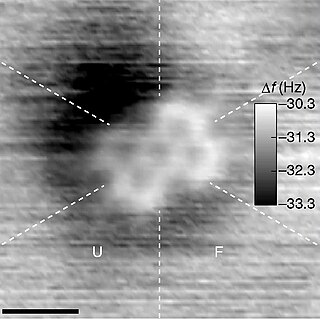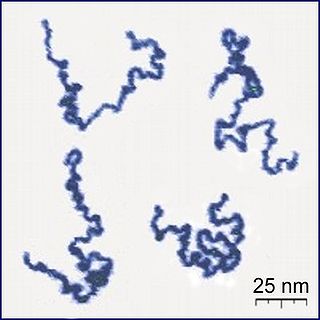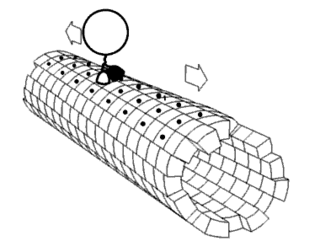
A chemist is a scientist trained in the study of chemistry. Chemists study the composition of matter and its properties. Chemists carefully describe the properties they study in terms of quantities, with detail on the level of molecules and their component atoms. Chemists carefully measure substance proportions, chemical reaction rates, and other chemical properties. In Commonwealth English, pharmacists are often called chemists.
A chemical formula is a way of presenting information about the chemical proportions of atoms that constitute a particular chemical compound or molecule, using chemical element symbols, numbers, and sometimes also other symbols, such as parentheses, dashes, brackets, commas and plus (+) and minus (−) signs. These are limited to a single typographic line of symbols, which may include subscripts and superscripts. A chemical formula is not a chemical name, and it contains no words. Although a chemical formula may imply certain simple chemical structures, it is not the same as a full chemical structural formula. Chemical formulae can fully specify the structure of only the simplest of molecules and chemical substances, and are generally more limited in power than chemical names and structural formulae.
Chemical evolution may refer to:

A molecule is an electrically neutral group of two or more atoms held together by chemical bonds. Molecules are distinguished from ions by their lack of electrical charge.

A polymer is a substance or material consisting of very large molecules, or macromolecules, composed of many repeating subunits. Due to their broad spectrum of properties, both synthetic and natural polymers play essential and ubiquitous roles in everyday life. Polymers range from familiar synthetic plastics such as polystyrene to natural biopolymers such as DNA and proteins that are fundamental to biological structure and function. Polymers, both natural and synthetic, are created via polymerization of many small molecules, known as monomers. Their consequently large molecular mass, relative to small molecule compounds, produces unique physical properties including toughness, high elasticity, viscoelasticity, and a tendency to form amorphous and semicrystalline structures rather than crystals.

Theoretical chemistry is the branch of chemistry which develops theoretical generalizations that are part of the theoretical arsenal of modern chemistry: for example, the concepts of chemical bonding, chemical reaction, valence, the surface of potential energy, molecular orbitals, orbital interactions, and molecule activation.

A macromolecule is a very large molecule, such as a protein. They are composed of thousands of covalently bonded atoms. Many macromolecules are the polymerization of smaller molecules called monomers. The most common macromolecules in biochemistry are biopolymers and large non-polymeric molecules such as lipids and macrocycles. Synthetic fibers and experimental materials such as carbon nanotubes are also examples of macromolecules.
CN, Cn, cn and other variants may refer to:

Food science is the basic science and applied science of food; its scope starts at overlap with agricultural science and nutrition and leads through the scientific aspects of food safety and food processing, informing the development of food technology. The Institute of Food Technologists defines food science as "the discipline in which the engineering, biological, and physical sciences are used to study the nature of foods, the causes of deterioration, the principles underlying food processing, and the improvement of foods for the consuming public". The textbook Food Science defines food science in simpler terms as "the application of basic sciences and engineering to study the physical, chemical, and biochemical nature of foods and the principles of food processing".

A chemical structure determination includes a chemist's specifying the molecular geometry and, when feasible and necessary, the electronic structure of the target molecule or other solid. Molecular geometry refers to the spatial arrangement of atoms in a molecule and the chemical bonds that hold the atoms together, and can be represented using structural formulae and by molecular models; complete electronic structure descriptions include specifying the occupation of a molecule's molecular orbitals. Structure determination can be applied to a range of targets from very simple molecules, to very complex ones.
Gluten exorphins are a group of opioid peptides formed during digestion of the gluten protein. It has been hypothesized that people with autism and schizophrenia have abnormal leakage from the gut of these compounds, which then pass into the brain and disrupt brain function, a process collectively known as the opioid excess theory or a part of leaky gut syndrome. This is partly the basis for the gluten-free, casein-free diet. The medical evidence is mixed. Two clinical studies of autism patients who followed this diet found no benefit. Another study found a benefit. Another study suggested the diet may present a greater risk to brain development.

A molecular machine, nanite, or nanomachine is a molecular component that produces quasi-mechanical movements (output) in response to specific stimuli (input). In cellular biology, macromolecular machines frequently perform tasks essential for life, such as DNA replication and ATP synthesis. The expression is often more generally applied to molecules that simply mimic functions that occur at the macroscopic level. The term is also common in nanotechnology where a number of highly complex molecular machines have been proposed that are aimed at the goal of constructing a molecular assembler.

Sir James Fraser Stoddart is a British chemist who is Board of Trustees Professor of Chemistry and head of the Stoddart Mechanostereochemistry Group in the Department of Chemistry at Northwestern University in the United States. He works in the area of supramolecular chemistry and nanotechnology. Stoddart has developed highly efficient syntheses of mechanically-interlocked molecular architectures such as molecular Borromean rings, catenanes and rotaxanes utilising molecular recognition and molecular self-assembly processes. He has demonstrated that these topologies can be employed as molecular switches. His group has even applied these structures in the fabrication of nanoelectronic devices and nanoelectromechanical systems (NEMS). His efforts have been recognized by numerous awards including the 2007 King Faisal International Prize in Science. He shared the Nobel Prize in Chemistry together with Ben Feringa and Jean-Pierre Sauvage in 2016 for the design and synthesis of molecular machines.
A chemical bonding model is a theoretical model used to explain atomic bonding structure, molecular geometry, properties, and reactivity of physical matter. This can refer to:

The Drexler–Smalley debate on molecular nanotechnology was a public dispute between K. Eric Drexler, the originator of the conceptual basis of molecular nanotechnology, and Richard Smalley, a recipient of the 1996 Nobel prize in Chemistry for the discovery of the nanomaterial buckminsterfullerene. The dispute was about the feasibility of constructing molecular assemblers, which are molecular machines which could robotically assemble molecular materials and devices by manipulating individual atoms or molecules. The concept of molecular assemblers was central to Drexler's conception of molecular nanotechnology, but Smalley argued that fundamental physical principles would prevent them from ever being possible. The two also traded accusations that the other's conception of nanotechnology was harmful to public perception of the field and threatened continued public support for nanotechnology research.
Octynes are alkynes with one triple bond and the molecular formula C8H14.
Nonynes are alkynes with one triple bond and the molecular formula C9H16.

Bernard Lucas Feringa is a Dutch synthetic organic chemist, specializing in molecular nanotechnology and homogeneous catalysis. He is the Jacobus van 't Hoff Distinguished Professor of Molecular Sciences, at the Stratingh Institute for Chemistry, University of Groningen, Netherlands, and an Academy Professor of the Royal Netherlands Academy of Arts and Sciences. He was awarded the 2016 Nobel Prize in Chemistry, together with Sir J. Fraser Stoddart and Jean-Pierre Sauvage, "for the design and synthesis of molecular machines".










